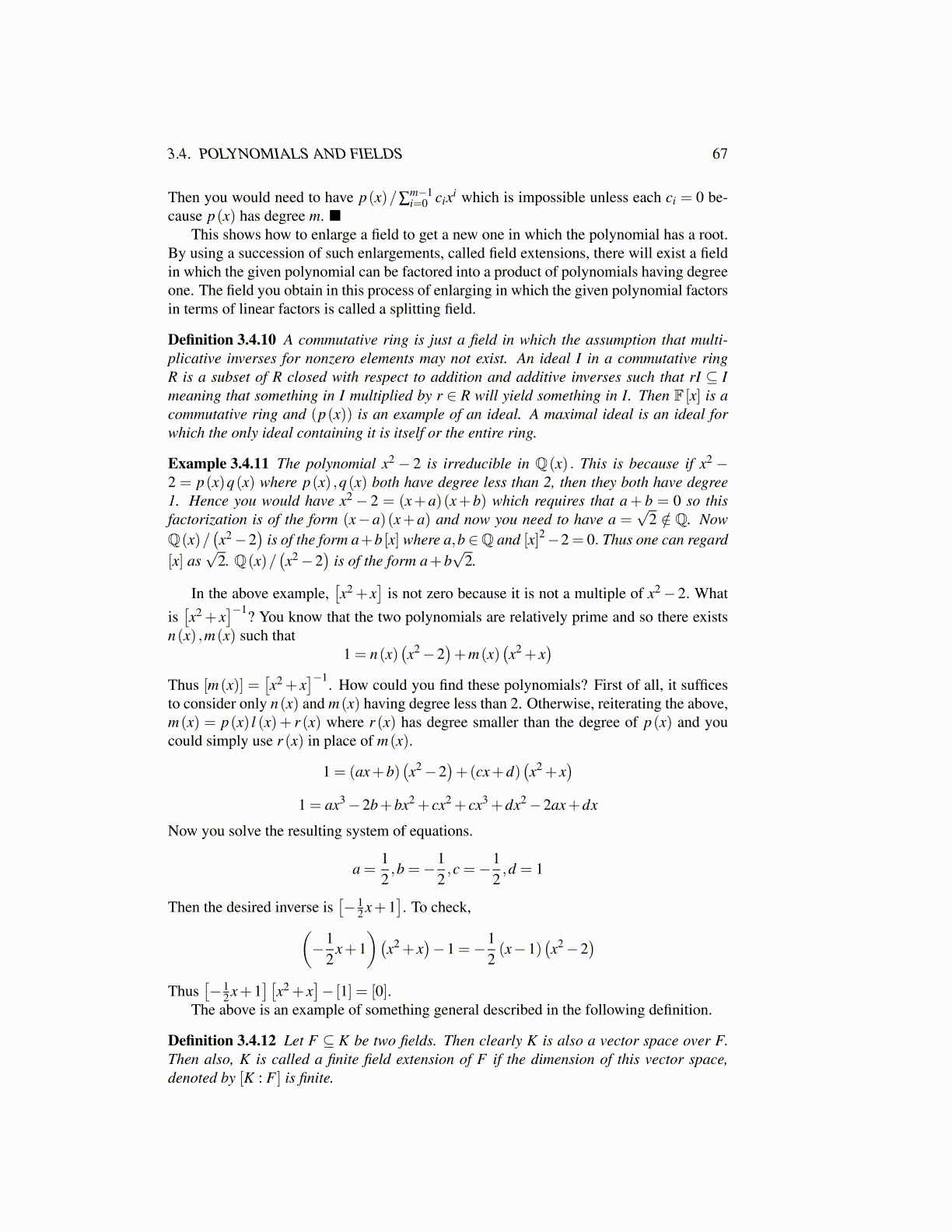
3.4. POLYNOMIALS AND FIELDS 67
Then you would need to have p(x)/∑m−1i=0 cixi which is impossible unless each ci = 0 be-
cause p(x) has degree m. ■This shows how to enlarge a field to get a new one in which the polynomial has a root.
By using a succession of such enlargements, called field extensions, there will exist a fieldin which the given polynomial can be factored into a product of polynomials having degreeone. The field you obtain in this process of enlarging in which the given polynomial factorsin terms of linear factors is called a splitting field.
Definition 3.4.10 A commutative ring is just a field in which the assumption that multi-plicative inverses for nonzero elements may not exist. An ideal I in a commutative ringR is a subset of R closed with respect to addition and additive inverses such that rI ⊆ Imeaning that something in I multiplied by r ∈ R will yield something in I. Then F [x] is acommutative ring and (p(x)) is an example of an ideal. A maximal ideal is an ideal forwhich the only ideal containing it is itself or the entire ring.
Example 3.4.11 The polynomial x2 − 2 is irreducible in Q(x) . This is because if x2 −2 = p(x)q(x) where p(x) ,q(x) both have degree less than 2, then they both have degree1. Hence you would have x2− 2 = (x+a)(x+b) which requires that a+ b = 0 so thisfactorization is of the form (x−a)(x+a) and now you need to have a =
√2 /∈ Q. Now
Q(x)/(x2−2
)is of the form a+b [x] where a,b∈Q and [x]2−2 = 0. Thus one can regard
[x] as√
2. Q(x)/(x2−2
)is of the form a+b
√2.
In the above example,[x2 + x
]is not zero because it is not a multiple of x2− 2. What
is[x2 + x
]−1? You know that the two polynomials are relatively prime and so there existsn(x) ,m(x) such that
1 = n(x)(x2−2
)+m(x)
(x2 + x
)Thus [m(x)] =
[x2 + x
]−1. How could you find these polynomials? First of all, it sufficesto consider only n(x) and m(x) having degree less than 2. Otherwise, reiterating the above,m(x) = p(x) l (x)+ r (x) where r (x) has degree smaller than the degree of p(x) and youcould simply use r (x) in place of m(x).
1 = (ax+b)(x2−2
)+(cx+d)
(x2 + x
)1 = ax3−2b+bx2 + cx2 + cx3 +dx2−2ax+dx
Now you solve the resulting system of equations.
a =12,b =−1
2,c =−1
2,d = 1
Then the desired inverse is[− 1
2 x+1]. To check,(
−12
x+1)(
x2 + x)−1 =−1
2(x−1)
(x2−2
)Thus
[− 1
2 x+1][
x2 + x]− [1] = [0].
The above is an example of something general described in the following definition.
Definition 3.4.12 Let F ⊆ K be two fields. Then clearly K is also a vector space over F.Then also, K is called a finite field extension of F if the dimension of this vector space,denoted by [K : F ] is finite.